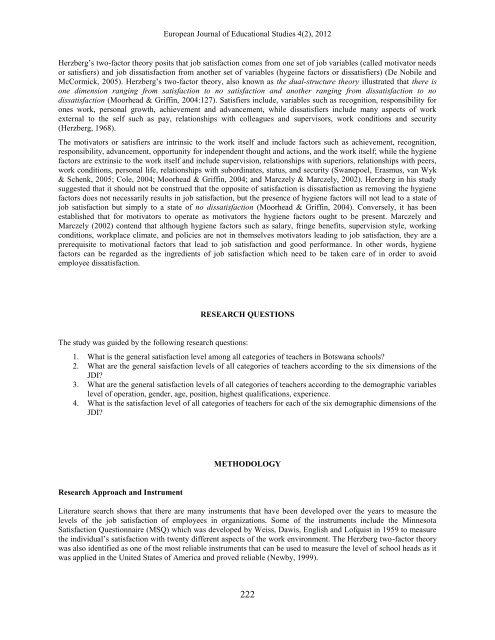the level of the job satisfaction of teachers in botswana pedzani ...
the level of the job satisfaction of teachers in botswana pedzani ...
the level of the job satisfaction of teachers in botswana pedzani ...
You also want an ePaper? Increase the reach of your titles
YUMPU automatically turns print PDFs into web optimized ePapers that Google loves.
European Journal <strong>of</strong> Educational Studies 4(2), 2012<br />
Herzberg‘s two-factor <strong>the</strong>ory posits that <strong>job</strong> <strong>satisfaction</strong> comes from one set <strong>of</strong> <strong>job</strong> variables (called motivator needs<br />
or satisfiers) and <strong>job</strong> dis<strong>satisfaction</strong> from ano<strong>the</strong>r set <strong>of</strong> variables (hyge<strong>in</strong>e factors or dissatisfiers) (De Nobile and<br />
McCormick, 2005). Herzberg‘s two-factor <strong>the</strong>ory, also known as <strong>the</strong> dual-structure <strong>the</strong>ory illustrated that <strong>the</strong>re is<br />
one dimension rang<strong>in</strong>g from <strong>satisfaction</strong> to no <strong>satisfaction</strong> and ano<strong>the</strong>r rang<strong>in</strong>g from dis<strong>satisfaction</strong> to no<br />
dis<strong>satisfaction</strong> (Moorhead & Griff<strong>in</strong>, 2004:127). Satisfiers <strong>in</strong>clude, variables such as recognition, responsibility for<br />
ones work, personal growth, achievement and advancement, while dissatisfiers <strong>in</strong>clude many aspects <strong>of</strong> work<br />
external to <strong>the</strong> self such as pay, relationships with colleagues and supervisors, work conditions and security<br />
(Herzberg, 1968).<br />
The motivators or satisfiers are <strong>in</strong>tr<strong>in</strong>sic to <strong>the</strong> work itself and <strong>in</strong>clude factors such as achievement, recognition,<br />
responsibility, advancement, opportunity for <strong>in</strong>dependent thought and actions, and <strong>the</strong> work itself; while <strong>the</strong> hygiene<br />
factors are extr<strong>in</strong>sic to <strong>the</strong> work itself and <strong>in</strong>clude supervision, relationships with superiors, relationships with peers,<br />
work conditions, personal life, relationships with subord<strong>in</strong>ates, status, and security (Swanepoel, Erasmus, van Wyk<br />
& Schenk, 2005; Cole, 2004; Moorhead & Griff<strong>in</strong>, 2004; and Marczely & Marczely, 2002). Herzberg <strong>in</strong> his study<br />
suggested that it should not be construed that <strong>the</strong> opposite <strong>of</strong> <strong>satisfaction</strong> is dis<strong>satisfaction</strong> as remov<strong>in</strong>g <strong>the</strong> hygiene<br />
factors does not necessarily results <strong>in</strong> <strong>job</strong> <strong>satisfaction</strong>, but <strong>the</strong> presence <strong>of</strong> hygiene factors will not lead to a state <strong>of</strong><br />
<strong>job</strong> <strong>satisfaction</strong> but simply to a state <strong>of</strong> no dis<strong>satisfaction</strong> (Moorhead & Griff<strong>in</strong>, 2004). Conversely, it has been<br />
established that for motivators to operate as motivators <strong>the</strong> hygiene factors ought to be present. Marczely and<br />
Marczely (2002) contend that although hygiene factors such as salary, fr<strong>in</strong>ge benefits, supervision style, work<strong>in</strong>g<br />
conditions, workplace climate, and policies are not <strong>in</strong> <strong>the</strong>mselves motivators lead<strong>in</strong>g to <strong>job</strong> <strong>satisfaction</strong>, <strong>the</strong>y are a<br />
prerequisite to motivational factors that lead to <strong>job</strong> <strong>satisfaction</strong> and good performance. In o<strong>the</strong>r words, hygiene<br />
factors can be regarded as <strong>the</strong> <strong>in</strong>gredients <strong>of</strong> <strong>job</strong> <strong>satisfaction</strong> which need to be taken care <strong>of</strong> <strong>in</strong> order to avoid<br />
employee dis<strong>satisfaction</strong>.<br />
RESEARCH QUESTIONS<br />
The study was guided by <strong>the</strong> follow<strong>in</strong>g research questions:<br />
1. What is <strong>the</strong> general <strong>satisfaction</strong> <strong>level</strong> among all categories <strong>of</strong> <strong>teachers</strong> <strong>in</strong> Botswana schools<br />
2. What are <strong>the</strong> general saisfaction <strong>level</strong>s <strong>of</strong> all categories <strong>of</strong> <strong>teachers</strong> accord<strong>in</strong>g to <strong>the</strong> six dimensions <strong>of</strong> <strong>the</strong><br />
JDI<br />
3. What are <strong>the</strong> general <strong>satisfaction</strong> <strong>level</strong>s <strong>of</strong> all categories <strong>of</strong> <strong>teachers</strong> accord<strong>in</strong>g to <strong>the</strong> demographic variables<br />
<strong>level</strong> <strong>of</strong> operation, gender, age, position, highest qualifications, experience.<br />
4. What is <strong>the</strong> <strong>satisfaction</strong> <strong>level</strong> <strong>of</strong> all categories <strong>of</strong> <strong>teachers</strong> for each <strong>of</strong> <strong>the</strong> six demographic dimensions <strong>of</strong> <strong>the</strong><br />
JDI<br />
METHODOLOGY<br />
Research Approach and Instrument<br />
Literature search shows that <strong>the</strong>re are many <strong>in</strong>struments that have been developed over <strong>the</strong> years to measure <strong>the</strong><br />
<strong>level</strong>s <strong>of</strong> <strong>the</strong> <strong>job</strong> <strong>satisfaction</strong> <strong>of</strong> employees <strong>in</strong> organizations. Some <strong>of</strong> <strong>the</strong> <strong>in</strong>struments <strong>in</strong>clude <strong>the</strong> M<strong>in</strong>nesota<br />
Satisfaction Questionnaire (MSQ) which was developed by Weiss, Dawis, English and L<strong>of</strong>quist <strong>in</strong> 1959 to measure<br />
<strong>the</strong> <strong>in</strong>dividual‘s <strong>satisfaction</strong> with twenty different aspects <strong>of</strong> <strong>the</strong> work environment. The Herzberg two-factor <strong>the</strong>ory<br />
was also identified as one <strong>of</strong> <strong>the</strong> most reliable <strong>in</strong>struments that can be used to measure <strong>the</strong> <strong>level</strong> <strong>of</strong> school heads as it<br />
was applied <strong>in</strong> <strong>the</strong> United States <strong>of</strong> America and proved reliable (Newby, 1999).<br />
222

















